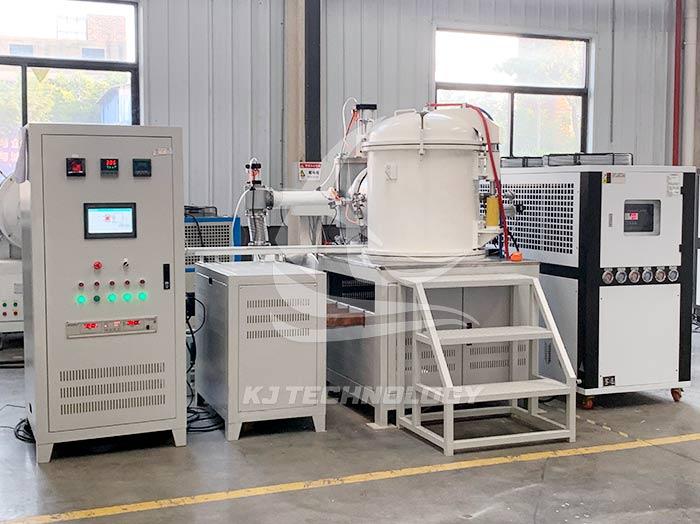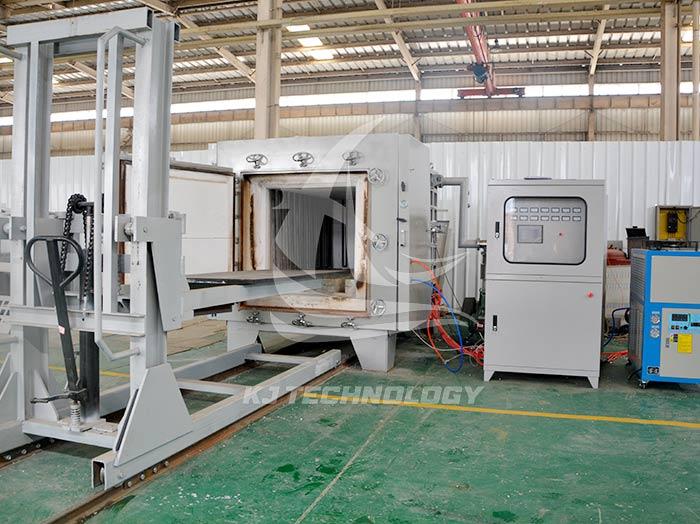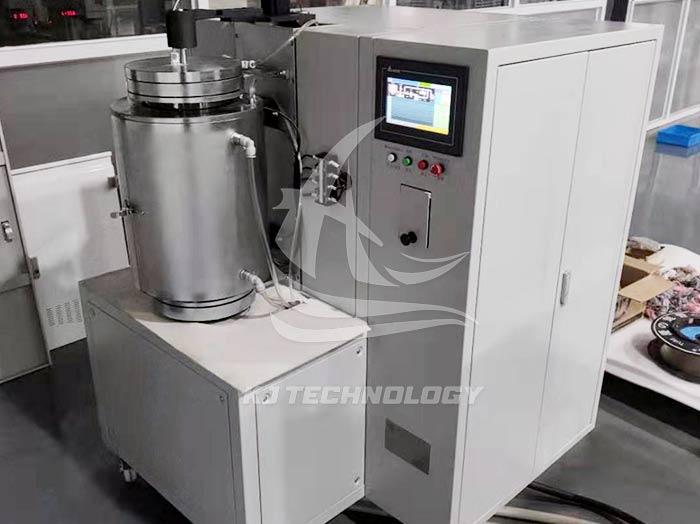Can an electric heating vacuum heat treatment furnace be used for annealing?
 08-14-2025 Author: KJ technology
08-14-2025 Author: KJ technology
The electric heating vacuum heat treatment furnace can be fully used for annealing processes. By combining vacuum environment with electric heating technology, it provides a high-precision, pollution-free, and highly adaptable solution for annealing, especially suitable for scenarios with strict requirements for material surface quality, dimensional accuracy, and performance uniformity. The following is a specific analysis:
1. The core role of vacuum environment in annealing
Prevent oxidation and decarbonization
Principle: In a vacuum environment (pressure ≤ 10 ⁻ ² Pa), oxidizing gases such as oxygen and water vapor are completely eliminated, avoiding surface oxidation and carbon loss of metal materials during high-temperature annealing.
effect:
After annealing, the surface smoothness of tool steel reaches Ra0.8 μ m or below, without the need for subsequent acid washing or polishing, reducing material loss by 10% -15%.
After vacuum annealing of high-speed steel (such as M2), the uniformity of carbide distribution is improved by 30%, and the hardness fluctuation range is reduced to within ± 1HRC.
Inhibit hydrogen embrittlement and cracking
Principle: A vacuum environment can reduce the solubility of hydrogen in metals, promote the diffusion and escape of hydrogen, and avoid cracks caused by hydrogen embrittlement.
effect:
After vacuum annealing, the hydrogen content of titanium alloys (such as TC4) decreases to below 0.002%, and the fracture toughness increases by 20%, meeting the requirements of aviation structural components.
When annealing spring steel, the vacuum environment reduces the thickness of the decarburization layer on the surface from 0.1mm to 0.02mm, and extends the fatigue life by 50%.
Stable material composition
Principle: The vacuum environment isolates the invasion of elements such as nitrogen and oxygen, avoiding the formation of nitride or oxide layers on the material surface.
effect:
After vacuum annealing, the surface chromium content of stainless steel (such as 304) remains above 18%, and its corrosion resistance is better than that of air annealing.
After annealing, nickel based high-temperature alloys (such as Inconel 718) have no segregation of aluminum and titanium elements on the surface, and the high-temperature strength retention rate reaches 95%.
2. Technical advantages of electric heating system
Accurate temperature control and uniform heating
Technology: Using molybdenum sheets, graphite or induction heating methods, combined with zone temperature control technology, to achieve temperature uniformity of ± 1 ℃.
effect:
During annealing of precision bearing steel, temperature fluctuations are controlled within ± 3 ℃, and hardness uniformity reaches ± 0.5HRC, meeting the requirements of high-precision parts.
When annealing semiconductor silicon wafers, the temperature gradient should be ≤ 5 ℃/cm to avoid lattice defects caused by thermal stress.
Wide temperature range coverage
Scope: The working temperature of electric heating vacuum furnace is usually 200 ℃~1300 ℃, which can meet the annealing needs of different materials such as low carbon steel (650-700 ℃), alloy steel (800-900 ℃), titanium alloy (700-850 ℃), etc.
Case: A certain model of vacuum annealing furnace can achieve stepless temperature regulation from 200 ℃ (stress relief annealing) to 1200 ℃ (high temperature annealing), suitable for multi variety and small batch production.
Efficient and energy-saving design
Efficiency: The thermal efficiency of the electric heating system is over 95%, which is 40% more energy-efficient than gas stoves and 25% more energy-efficient than resistance stoves.
Case: When processing 1 ton of workpiece, the energy consumption of the vacuum annealing furnace is only 800 kWh, while the air annealing furnace requires 1200 kWh, reducing costs by 30%.
3. Typical Annealing Process and Application Scenarios
Complete annealing (softening annealing)
Purpose: To reduce hardness and improve machinability.
workmanship
Carbon steel: heated to Ac3+30-50 ℃, insulated and cooled in the furnace to below 500 ℃ before being removed from the furnace.
Alloy steel: Heat to Ac1+30-50 ℃, keep warm and cool slowly.
effect:
After vacuum annealing, the hardness of 45 # steel decreased to HB160-180, the cutting force decreased by 20%, and the tool life was extended by 30%.
After annealing, the uniformity of the microstructure of mold steel (such as H13) is improved, and the quenching crack rate is reduced from 5% to 0.5%.
spheroidizing annealing
Objective: To obtain spherical pearlite and improve its cold deformation performance.
workmanship
High carbon steel: heated to Ac1+20-30 ℃, insulated and slowly cooled to below Ar1.
Tool steel: isothermal spheroidization method is used, with insulation at 760-780 ℃ and isothermal at 680-700 ℃.
effect:
After vacuum spheroidization annealing of T10 steel, the carbide spheroidization rate reaches over 90%, and the hardness uniformity is improved by 25%.
After annealing, the carbide size of high-speed steel (such as W18Cr4V) is refined from 5-10 μ m to 2-5 μ m, and the grindability is improved by 40%.
Stress relief annealing
Purpose: To eliminate residual stresses from processing or welding.
workmanship
Low carbon steel: heated to 500-650 ℃, insulated and air-cooled.
Titanium alloy: heated to 450-550 ℃, insulated and then cooled in the furnace.
effect:
After vacuum annealing of welded structural components, residual stress is reduced by 80% -90% and dimensional stability is improved by 50%.
After annealing, the deformation of precision gears decreased from 0.1mm to 0.02mm, meeting the requirements of high-precision transmission.
Recrystallization annealing
Purpose: To eliminate cold work hardening and restore plasticity.
workmanship
Copper alloy: Heat to 300-400 ℃, keep warm, and then water cool.
Aluminum alloy: heated to 350-400 ℃, insulated and air-cooled.
effect:
After annealing, the elongation of cold-rolled copper sheet increased from 8% to 35%, and the conductivity recovered to 98% IACS.
After annealing, the tensile strength of 6061 aluminum alloy decreased from 300MPa to 180MPa, and the plasticity increased by 100%.
4. Suggestions for equipment type and process selection
Single chamber vacuum furnace
Features: Simple structure, low cost, suitable for small batch production.
Application: Spheroidization annealing of tool steel and mold steel, stress relief annealing of precision parts.
Dual chamber/multi chamber vacuum furnace
Features: Seamless connection of furnace loading, annealing, and cooling is achieved through continuous operation, increasing productivity by more than 50%.
Application: Large scale annealing of automotive components and aviation structural parts.
High pressure gas quenching vacuum furnace
Features: After annealing, it can be directly subjected to high-pressure gas quenching (pressure ≥ 2MPa), achieving an integrated process of "annealing+quenching".
Application: Composite heat treatment of high-speed steel and mold steel, reducing production cycle by 30%.
5. Case study of process parameter optimization
Material: 304 stainless steel (thickness 2mm)
Purpose: To eliminate cold rolling stress and restore plasticity
workmanship
Vacuum degree: 1 × 10 ⁻ ³ Pa
Heating temperature: 850 ℃
Insulation time: 2 hours
Cooling method: furnace cooling to 400 ℃ and then air cooling
effect:
Residual stress decreased from 280MPa to 30MPa
Extension rate increased from 15% to 45%
Surface roughness Ra decreased from 1.6 μ m to 0.4 μ m








